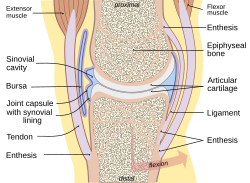Enthesis
| Enthesis | |
|---|---|

Typical Joint
|
|
| Identifiers | |
| Code | TH H3.03.00.0.00034 |
|
Anatomical terminology
[]
|
|
The enthesis (plural: entheses) is the connective tissue between tendon or ligament and bone.
There are two types of entheses: Fibrous entheses and fibrocartilaginous entheses.
In a fibrous enthesis, the collagenous tendon or ligament directly attaches to the bone, whereas the fibrocartilaginous interface encompasses four transition zones:
"Enthesis" is rooted in the Ancient Greek word, "ἔνθεσις" or "énthesis," meaning “putting in," or "insertion." This refers to the role of the enthesis as the site of attachment of bones with tendons or ligaments. Relatedly, in muscle terminology, the insertion is the site of attachment at the end with predominant movement or action (opposite of the origin). Thus the words (enthesis and insertion [of muscle]) are proximal in the semantic field, but insertion in reference to muscle can refer to any relevant aspect of the site (i.e., the attachment per se, the bone, the tendon, or the entire area), whereas enthesis refers to the attachment per se and to ligamentous attachments as well as tendinous ones.
A disease of the entheses is known as an enthesopathy or enthesitis. Enthetic degeneration is characteristic of spondyloarthropathy and other pathologies.
The enthesis is the primary site of disease in ankylosing spondylitis.
Entheses are widely recorded in the field of bioarchaeology where the presence of anomalies at these sites, called entheseal changes, has been used to infer repetitive loading to study the division of labour in past populations. Several different recording methods have been proposed to record the variety of changes seen at these sites. However, research has shown that, whichever recording method is used, entheseal changes occur more frequently in older individuals. Clinical research demonstrates that diseases, such as ankylosing spondylitis, have to be taken into consideration.
...
Wikipedia
